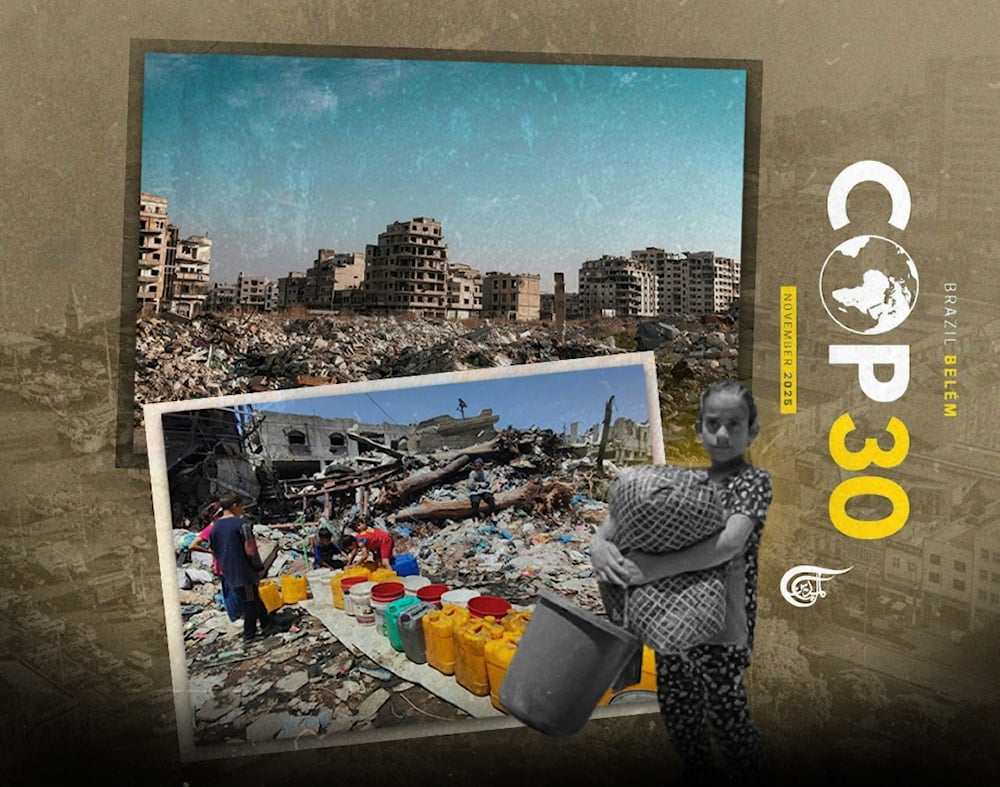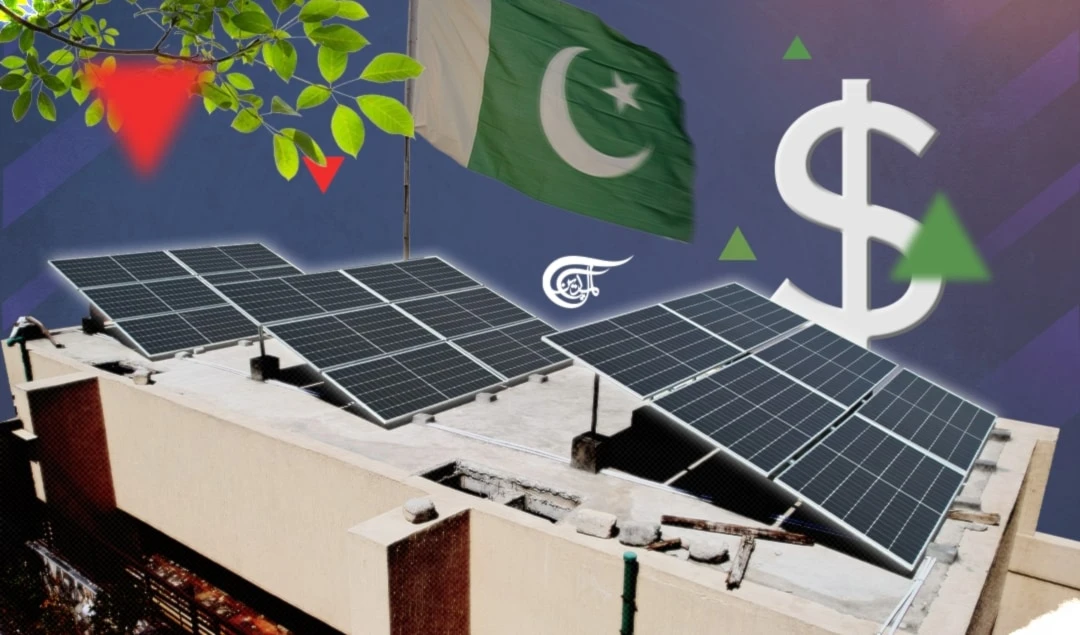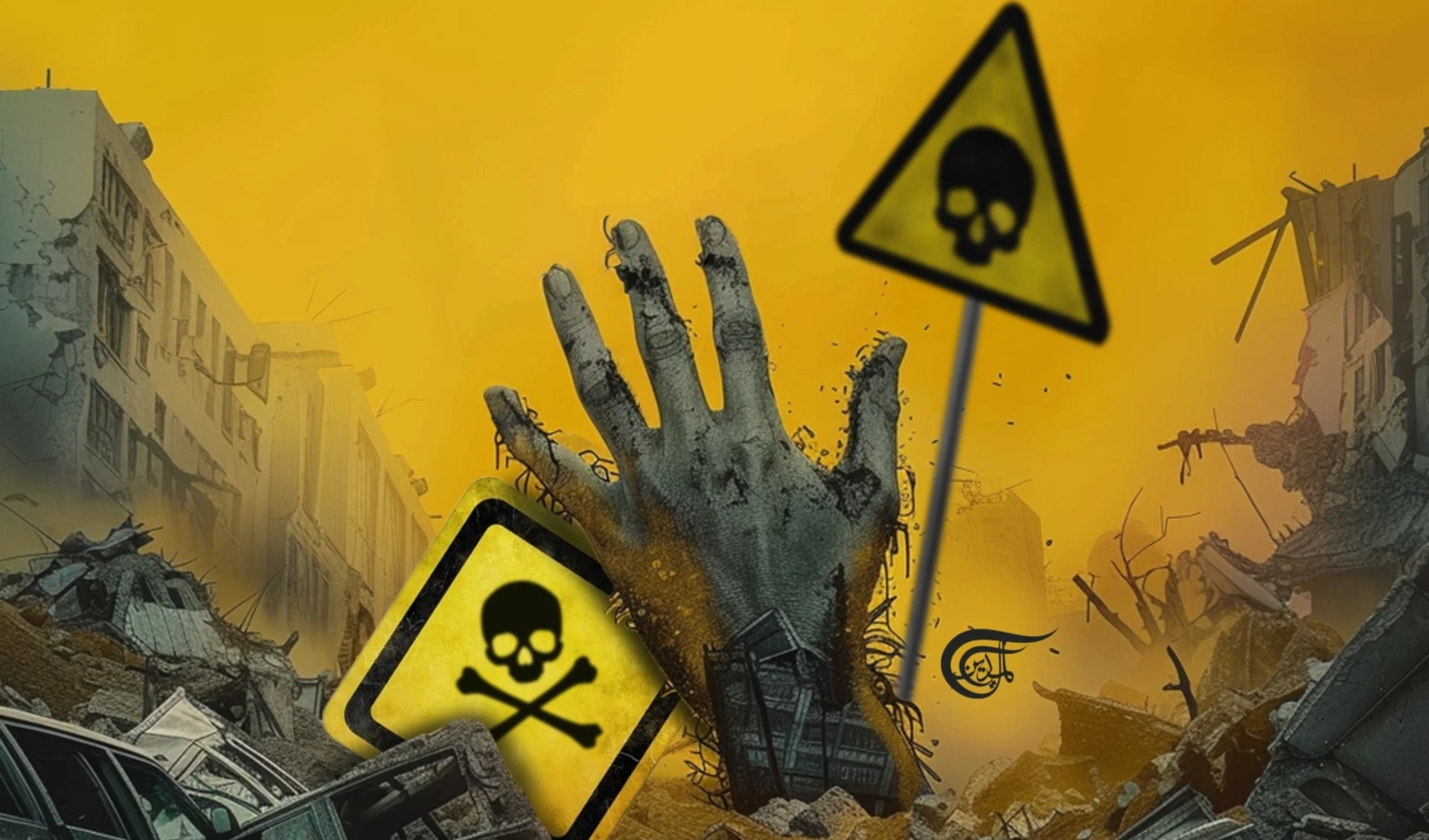Call it Gazacide: Ecocide and systematic environmental destruction in Gaza
Parisа Nasrabadi exposes "Israel’s" systematic destruction of Gaza’s environment as a form of settler-colonial violence, an intentional ecocide threatening Gaza’s soil, water, and future, demanding recognition at COP30 as part of global climate justice.
-

Civil society, environmental activists, and some states may succeed in raising the profile of Gaza’s ecocide, potentially spurring side events or statements at COP30. (Al Mayadeen English; Illustrated by Zeinab el-Hajj)
The ongoing destruction of Gaza is more than a tragedy for Palestinians; it represents a broader pattern of settler-colonial violence against them. “Gazacide” frames the ecological devastation in Gaza as an intentional component of this violence, linking the destruction of civilian infrastructure, communities, and the social, cultural, and ecological fabric of Palestinian life to the broader harm experienced by its inhabitants.
Gazacide refers to the widespread and organized damage to the environment caused by the current Israeli military campaign, which is seriously harming Gaza's natural resources and agriculture, putting the area's future at risk.
Before delving into the specific ecological challenges Gaza faces, it is vital to consider the upcoming COP30 as a pivotal moment for international advocacy and support.
COP30 will take place in Brazil from November 10 to November 25, presenting an opportunity to elevate Gaza’s environmental crisis as part of a broader climate justice and humanitarian agenda. While concrete binding actions may be challenging amid geopolitical sensitivities, the conference can catalyze monitoring, funding for restoration, and cross-sector collaborations to address ecocide and its health, water, and soil impacts. A focused push for independent assessments, transparent data sharing, and pilot restoration projects could lay the groundwork for accelerated action in future iterations of the talks.
Environmental destruction across Gaza: A catastrophic landscape
By mid-2025, assessments from multiple research collaborations and international bodies will indicate an unprecedented scale of environmental deterioration in Gaza. For instance, UN Environment Program (UNEP) data showed that approximately 97% of Gaza’s tree crops, 82% of annual crops, and 95% of shrubland had been destroyed. Key indicators include the widespread loss of tree crops, annual crops, and shrublands, with cascading effects on biodiversity and ecosystem services.
Destruction extends beyond living vegetation to the water cycle, soil, and air quality, threatening the region’s agricultural base, food security, and future livelihoods. As a cruel reminder, it should be noted that from October 7 to November 1, 2023, Israeli forces dropped approximately 18,000 tons of explosives, equivalent to about 1.5 times the bombs the US dropped on Hiroshima during World War II. This brief period of Gazacide highlights the scale of devastation in Gaza.
Water, Soil, and Air
The collapse or near-collapse of water and sewage infrastructure has led to groundwater and coastal water contamination, including untreated sewage entering the Mediterranean. The knock-on effects include deteriorating drinking water quality, increased disease risk, and heightened pressure on a population that is already coping with restricted access to safe water.
Additionally, the remains of bombing, unexploded ordnance, and debris from destroyed buildings contribute to heavy metal and toxic residue contamination of soils, undermining soil health and crop productivity for years. Moreover, the destruction of fields, greenhouses, and orchards has reduced the capacity for large-scale food production and exposed farming communities to economic precarity and food insecurity.
Ongoing military activity also contributes to greenhouse gas emissions and local air pollution, with potential long-term climate effects that compound human vulnerability in an already stressed environment.
Effects on civilians and ecosystems
Ecological collapse intersects with humanitarian crises in tangible ways. Food security is one of the most vital necessities that is affected by any means. For a population already strained by conflict, the loss of arable land and disruption of irrigation systems undermine food production and access to nutritious foods. Water scarcity and quality are also significant commodities. Contaminated water supplies and depleted groundwater resources threaten basic human needs and public health in many countries.
Public health emergencies are also caused by polluted water, inadequate sanitation, and degraded air quality, driving disease burdens with long-term health implications for children and vulnerable groups.
As a result, soil degradation, habitat destruction, and pollution inevitably reduce biodiversity and the resilience of local ecosystems to cope with climate variability and future shocks.
Regarding the certainty of the ecocidal effects of the Israeli military aggression, a growing body of legal scholarship and environmental justice advocacy argues that the scale, duration, and purposeful character of ecological harm in Gaza meet or approach the recognized concepts of ecocide under prevailing international law discussions. Although not yet codified in a treaty, these views contribute to ongoing debates about accountability, deterrence, and remedies in armed conflict.
Forensic investigations, satellite imagery, water quality data, and field studies by academic–grassroots collaborations aim to document environmental harm, establish baselines, and support claims of accountability. This work is essential for informing policy responses, guiding reconstruction, and anchoring future legal and political proceedings.
Environmental Impacts in Detail
The Gaza ecocide is best understood as a confluence of deliberate or near-deliberate ecological destruction, long-term harm to livelihoods, and profound humanitarian consequences. It demands a multidimensional response, emergency relief to address urgent needs, independent environmental assessments, and coordinated accountability measures that might include international scrutiny, sanctions, or prosecutorial action where admissible under international law.
Irrigation water salinity and soil health
Groundwater salinity in areas such as al-Mawasi, al-Qarara, and Khan Younis has risen sharply due to over-pumping to supply Internally Displaced Persons (IDP), with olive nurseries and other crops failing as salinity thresholds increase. This trend increases the risk of long-term soil degradation and loss of agroecological productivity.
Field observations document repeated intensive bombing that causes soil burning, organic matter loss, and structural disruption. Explosive events elevate soil temperatures and damage soil biology, resulting in reduced fertility and impaired permeability. Heavy machinery and shelling further compact the soil, impeding water infiltration and root growth, while desiccation and surface disturbance reduce soil moisture and seedbed quality.
Rebuilding soil health requires replacing the topsoil, applying organic amendments, and practicing careful tillage to restore the soil structure, water-holding capacity, and microbial activity. These interventions are essential for the meaningful restoration of agriculture.
Soil contaminants and heavy metals
Given the intensity of bombing and industrial disruption, the presence of heavy metals (such as chromium, nickel, copper, cobalt, and lead) in soils warrants systematic sampling and analysis. By May 2025, the Gaza authorities estimated that "Israel" had dropped 100,000 tons of explosives on the enclave.
According to the head of the Palestinian Authority’s environmental activities office, during the aggressions in the Gaza Strip, "40-70 thousand tons of explosives were dropped on this narrow area. The Israeli regime used 100 military aircraft and 400 tanks, and military vehicles, polluting the air with fuel emissions and harmful substances."
International oversight is necessary to ensure safety and compliance with humanitarian norms in suspected cases of radiological contamination. Contaminated soils transfer pollutants into crops, posing risks to food safety and public health. Monitoring of crops, leaves, and fruits is recommended to prevent the transfer of contaminants into the food chain.
Solid waste and wastewater management
Due to restrictions on access to designated landfills and the destruction of municipal infrastructure, thousands of tons of waste accumulate at unregulated sites near refugee camps. This creates breeding grounds for disease vectors and increases exposure to hazardous substances.
Large volumes of untreated sewage contaminate surface and groundwater, contributing to disease outbreaks and threatening the health of coastal and aquifer ecosystems. The closure or disruption of wastewater treatment facilities exacerbates flood risk and long-term environmental degradation.
Water supply and access
Displaced populations face severe constraints in accessing safe drinking water. Desalination facilities and external water supplies are critical; however, overall water availability for other purposes has fallen sharply, raising concerns about sanitation, hygiene, and health outcomes.
Elevated contamination levels threaten not only drinking water but also agricultural irrigation and the health of ecosystems. Groundwater and surface water quality remain central pillars of public health and climate resilience in Gaza.
Ecology and global health
Satellite imagery and field reports indicate the extensive loss of croplands, tree crops, and natural vegetation. The scale of loss denotes not only immediate hunger risks but also long-term ecological impoverishment, including habitat fragmentation and declines in pollinator populations, which are essential for crop productivity.
Habitat degradation, combined with soil and water pollution, puts pressure on local biodiversity and disrupts the ecological networks that support agricultural systems.
Global and regional implications
Contamination of groundwater and coastal waters can have transboundary effects, influencing neighboring ecosystems and, by extension, regional marine health and livelihoods dependent on shared resources.
As a chronic stressor on water resources and agriculture, climate change–driven variability intensifies competition for scarce resources, potentially shaping migration patterns, urban planning, and regional security dynamics.
Ecocide as a war crime
The term “Ecocide” captures the scale and intent of environmental destruction that disrupts ecological integrity and human well-being. Although not universally codified as a standalone crime, ecocide is increasingly discussed in relation to acts of war and modern battlefield conduct.
Some analyses argue that certain environmental destruction patterns in Gaza align with war crime criteria under international law, particularly when actions are deliberate, widespread, and long-lasting, and when they cause significant harm disproportionate to military objectives.
Regrettably, environmental degradation intersects with humanitarian law, civilian protection, and the duties of occupying or conducting military operations. A path toward accountability may involve international investigations, commissions of inquiry, or future treaty developments that clarify environmental protections in armed conflict.
Although the ecological catastrophe in Gaza has implications for international humanitarian law, environmental law, and the ethics of warfare, policymakers and international actors cannot reach and apply immediate relief, environmental remediation, or mechanisms to deter or punish environmental degradation in conflict zones.
The Gaza ecocide narrative points out that clear norms govern environmental protection during armed conflict, including accountability mechanisms and resilient reconstruction frameworks that prioritize ecosystems, water security, and public health. A rigorous, evidence-informed narrative that distinguishes between immediate battlefield damage and long-term ecological degradation helps audiences understand the stakes and demands accountability without conflating war crimes with humanitarian relief efforts.
Furthermore, collaborative interdisciplinary work is essential to document harm, monitor remediation efforts, and advocate for justice and reparations. Community engagement is critical to ensure that environmental restoration aligns with resistance foundations, local needs, livelihoods, and cultural ties to land and water.
However, the deficiency of “Law Enforcement” is a significant issue, as none of the mentioned actors or factors are capable of applying the necessary power to advance the process and initiate projects aimed at resilient reconstruction, ecosystem revival, and empowering the surviving inhabitants.
Final words…
The ecocide in Gaza represents a convergence of ecological devastation, humanitarian catastrophe, and legal challenges. The scale and persistence of environmental destruction, combined with its social, economic, and health impacts, demand urgent action. The international community bears the responsibility of documenting harm with methodological rigor, safeguarding civilians, and pursuing avenues for accountability. Reconstruction must be designed not merely to restore what existed but to build resilient systems, water security, soil health, and sustainable agriculture, that can weather future shocks and support a living and thriving Gaza.
Realistically, hope for concrete and effective action specifically targeting the ecocide in Gaza at COP30 is cautiously moderate and constrained by significant political and diplomatic challenges in the region. While strong binding measures specifically addressing Gaza’s ecocide are unlikely at COP30 because of geopolitical complexity, realistic hope lies in incremental progress: heightened visibility, advocacy successes, and initial frameworks for accountability and resource mobilization that could expand in later COPs and related UN processes.
The Gaza genocide is highly politicized within the UN and international forums because of political sensitivities and divisions. While environmental and climate issues receive broad support, issues tied to specific conflicts and wars, especially those involving Palestine, often face diplomatic pressures that can limit consensus or concrete resolutions.
However, the growing recognition of ecocide and climate justice in Gaza is still conceivable.
There is increased awareness and advocacy for integrating conflict-driven environmental harm into climate justice discussions. Civil society, environmental activists, and some states may succeed in raising the profile of Gaza’s ecocide, potentially spurring side events or statements at COP30.
Even though COP30 may set the potential groundwork for future accountability and funding mechanisms addressing conflict-related environmental damage, the situation is not optimal for expecting immediate solutions. But despite that, it is a must to raise voices against Gazacide by any means, on any occasion.

 Parisa Nasrabadi
Parisa Nasrabadi
 12 Min Read
12 Min Read







